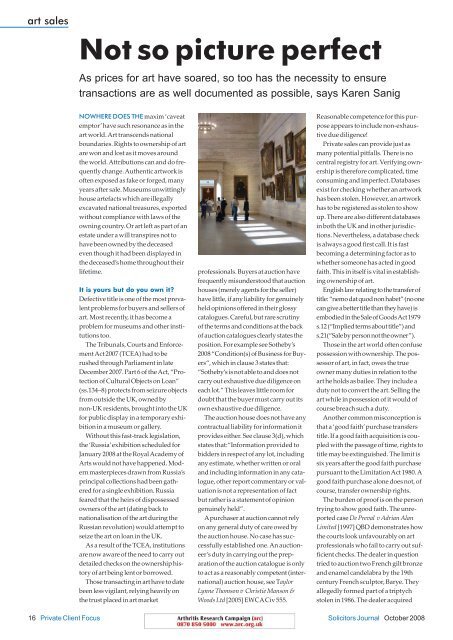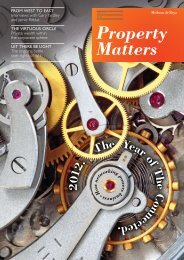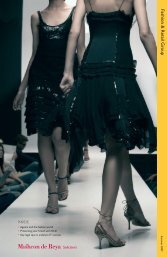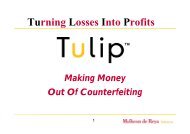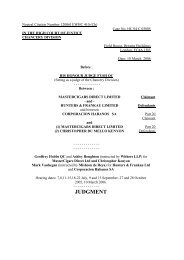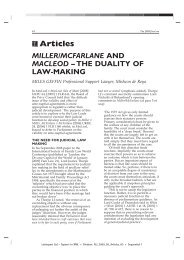Download PDF - Mishcon de Reya
Download PDF - Mishcon de Reya
Download PDF - Mishcon de Reya
Create successful ePaper yourself
Turn your PDF publications into a flip-book with our unique Google optimized e-Paper software.
art sales<br />
Not so picture perfect<br />
As prices for art have soared, so too has the necessity to ensure<br />
transactions are as well documented as possible, says Karen Sanig<br />
NOWHERE DOES THE maxim ‘caveat<br />
emptor’ have such resonance as in the<br />
art world. Art transcends national<br />
boundaries. Rights to ownership of art<br />
are won and lost as it moves around<br />
the world. Attributions can and do frequently<br />
change. Authentic artwork is<br />
often exposed as fake or forged, many<br />
years after sale. Museums unwittingly<br />
house artefacts which are illegally<br />
excavated national treasures, exported<br />
without compliance with laws of the<br />
owning country. Or art left as part of an<br />
estate un<strong>de</strong>r a will transpires not to<br />
have been owned by the <strong>de</strong>ceased<br />
even though it had been displayed in<br />
the <strong>de</strong>ceased’s home throughout their<br />
lifetime.<br />
It is yours but do you own it<br />
Defective title is one of the most prevalent<br />
problems for buyers and sellers of<br />
art. Most recently, it has become a<br />
problem for museums and other institutions<br />
too.<br />
The Tribunals, Courts and Enforcement<br />
Act 2007 (TCEA) had to be<br />
rushed through Parliament in late<br />
December 2007. Part 6 of the Act, “Protection<br />
of Cultural Objects on Loan”<br />
(ss.134–8) protects from seizure objects<br />
from outsi<strong>de</strong> the UK, owned by<br />
non-UK resi<strong>de</strong>nts, brought into the UK<br />
for public display in a temporary exhibition<br />
in a museum or gallery.<br />
Without this fast-track legislation,<br />
the ‘Russia’ exhibition scheduled for<br />
January 2008 at the Royal Aca<strong>de</strong>my of<br />
Arts would not have happened. Mo<strong>de</strong>rn<br />
masterpieces drawn from Russia’s<br />
principal collections had been gathered<br />
for a single exhibition. Russia<br />
feared that the heirs of dispossessed<br />
owners of the art (dating back to<br />
nationalisation of the art during the<br />
Russian revolution) would attempt to<br />
seize the art on loan in the UK.<br />
As a result of the TCEA, institutions<br />
are now aware of the need to carry out<br />
<strong>de</strong>tailed checks on the ownership history<br />
of art being lent or borrowed.<br />
Those transacting in art have to date<br />
been less vigilant, relying heavily on<br />
the trust placed in art market<br />
professionals. Buyers at auction have<br />
frequently misun<strong>de</strong>rstood that auction<br />
houses (merely agents for the seller)<br />
have little, if any liability for genuinely<br />
held opinions offered in their glossy<br />
catalogues. Careful, but rare scrutiny<br />
of the terms and conditions at the back<br />
of auction catalogues clearly states the<br />
position. For example see Sotheby’s<br />
2008 “Condition(s) of Business for Buyers“,<br />
which in clause 3 states that:<br />
“Sotheby’s is not able to and does not<br />
carry out exhaustive due diligence on<br />
each lot.” This leaves little room for<br />
doubt that the buyer must carry out its<br />
own exhaustive due diligence.<br />
The auction house does not have any<br />
contractual liability for information it<br />
provi<strong>de</strong>s either. See clause 3(d), which<br />
states that:“Information provi<strong>de</strong>d to<br />
bid<strong>de</strong>rs in respect of any lot, including<br />
any estimate, whether written or oral<br />
and including information in any catalogue,<br />
other report commentary or valuation<br />
is not a representation of fact<br />
but rather is a statement of opinion<br />
genuinely held”.<br />
A purchaser at auction cannot rely<br />
on any general duty of care owed by<br />
the auction house. No case has successfully<br />
established one. An auctioneer’s<br />
duty in carrying out the preparation<br />
of the auction catalogue is only<br />
to act as a reasonably competent (international)<br />
auction house, see Taylor<br />
Lynne Thomson v Christie Manson &<br />
Woods Ltd [2005] EWCA Civ 555.<br />
Reasonable competence for this purpose<br />
appears to inclu<strong>de</strong> non-exhaustive<br />
due diligence!<br />
Private sales can provi<strong>de</strong> just as<br />
many potential pitfalls. There is no<br />
central registry for art. Verifying ownership<br />
is therefore complicated, time<br />
consuming and imperfect. Databases<br />
exist for checking whether an artwork<br />
has been stolen. However, an artwork<br />
has to be registered as stolen to show<br />
up. There are also different databases<br />
in both the UK and in other jurisdictions.<br />
Nevertheless, a database check<br />
is always a good first call. It is fast<br />
becoming a <strong>de</strong>termining factor as to<br />
whether someone has acted in good<br />
faith. This in itself is vital in establishing<br />
ownership of art.<br />
English law relating to the transfer of<br />
title: “nemo dat quod non habet” (no one<br />
can give a better title than they have) is<br />
embodied in the Sale of Goods Act 1979<br />
s.12 (“Implied terms about title”) and<br />
s.21(“Sale by person not the owner”).<br />
Those in the art world often confuse<br />
possession with ownership. The possessor<br />
of art, in fact, owes the true<br />
owner many duties in relation to the<br />
art he holds as bailee. They inclu<strong>de</strong> a<br />
duty not to convert the art. Selling the<br />
art while in possession of it would of<br />
course breach such a duty.<br />
Another common misconception is<br />
that a ‘good faith’ purchase transfers<br />
title. If a good faith acquisition is coupled<br />
with the passage of time, rights to<br />
title may be extinguished. The limit is<br />
six years after the good faith purchase<br />
pursuant to the Limitation Act 1980. A<br />
good faith purchase alone does not, of<br />
course, transfer ownership rights.<br />
The bur<strong>de</strong>n of proof is on the person<br />
trying to show good faith. The unreported<br />
case De Preval v Adrian Alan<br />
Limited [1997] QBD <strong>de</strong>monstrates how<br />
the courts look unfavourably on art<br />
professionals who fail to carry out sufficient<br />
checks. The <strong>de</strong>aler in question<br />
tried to auction two French gilt bronze<br />
and enamel can<strong>de</strong>labra by the 19th<br />
century French sculptor, Barye. They<br />
allegedly formed part of a triptych<br />
stolen in 1986. The <strong>de</strong>aler acquired<br />
16 Private Client Focus Solicitors Journal October 2008
art sales<br />
them in New York ‘in good faith’ and<br />
relied on the word of the person selling<br />
them to him that he had the right to sell<br />
them unencumbered. Documents to<br />
support the acquisition were scant.<br />
They were put into a Sotheby’s sale in<br />
1994 but the original owner came forward<br />
to stop it. The case turned on<br />
whether she was barred from bringing<br />
her claim because there had been a<br />
good faith purchase over six years previously.<br />
The judge found that given the<br />
<strong>de</strong>aler’s expert knowledge as an experienced<br />
antiques <strong>de</strong>aler he ought to<br />
have realised that the can<strong>de</strong>labra were<br />
rare and special. As such, he ought to<br />
have doubted the seller’s title. It was<br />
<strong>de</strong>ci<strong>de</strong>d that the <strong>de</strong>aler had not acted<br />
in good faith at the time of acquisition<br />
because he relied only on the word of<br />
the seller to verify ownership. The rarity<br />
of the item ought to have alerted<br />
him to making greater checks about<br />
their ownership history.<br />
Today, checking the can<strong>de</strong>labra on a<br />
stolen art database would probably be<br />
sufficient to <strong>de</strong>termine the matter in<br />
the <strong>de</strong>aler’s favour. However, if the<br />
<strong>de</strong>aler checked the database and they<br />
were not registered as stolen, would<br />
the court find he had acted in good<br />
faith if he then sold them<br />
Due diligence has evolved since<br />
1997. Today we see more careful<br />
checks being carried out but they are<br />
far from perfect. See for example a<br />
report in the October 2008 edition of<br />
the Art Newspaper which recounts that<br />
Christie’s has sold 14 miniatures stolen<br />
from a public gallery. Christie’s had<br />
apparently checked the two databases<br />
but the miniatures were only recor<strong>de</strong>d<br />
on one and no photograph of them<br />
appeared on the other.<br />
In practice, sales by auction often<br />
confuse the question of ownership<br />
long enough for multiple sales of<br />
stolen artworks to take place. This coupled<br />
with the mobility of art often<br />
transfers title and complicates matters.<br />
Whereas English law favours the dispossessed<br />
owner, many continental<br />
jurisdictions favour the innocent purchaser.<br />
In France for example, (Article 2279<br />
Co<strong>de</strong> Civil) : “possession vaut titre”<br />
(possession equals ownership). Good<br />
title is obtained three years following a<br />
good faith acquisition and good faith is<br />
assumed. It is for the dispossessed<br />
owner to show bad faith.<br />
Consi<strong>de</strong>r also how the movement of<br />
art affects its ownership, for example<br />
where art stolen in the UK is sold<br />
abroad and then returned to the UK for<br />
sale. In the case of Winkworth v Christie<br />
Manson and Woods [1980] 1 All ER, art<br />
stolen in the UK was transferred to<br />
Italy.<br />
There it was sold to an innocent<br />
third party. Title was transferred to the<br />
unsuspecting purchaser according to<br />
Italian law. The art was offered for sale<br />
at auction in the UK. The original<br />
owner was unsuccessful in stopping<br />
the sale because of the transfer of title<br />
un<strong>de</strong>r Italian law.<br />
Uncommon solutions<br />
Recent draconian legislation, <strong>de</strong>signed<br />
to stop the trafficking in cultural heritage<br />
property, highlights the dangers<br />
of <strong>de</strong>aling in art without verifying<br />
ownership.<br />
The recent Dealing in Cultural<br />
Objects (Offences) Act 2003 provi<strong>de</strong>s<br />
for criminal sanctions as follows:<br />
(1) a person is guilty of an offence if he<br />
dishonestly <strong>de</strong>als in a cultural<br />
object that is tainted, knowing or<br />
believing that the object is tainted.<br />
(2) it is immaterial whether he knows<br />
or believes that the object is a cultural<br />
object.<br />
(3) a person found guilty of the offence<br />
is liable –<br />
(a) on conviction on indictment, to<br />
imprisonment for a term not<br />
exceeding seven years or a fine<br />
(or both);<br />
(b)on summary conviction, to<br />
imprisonment for a term not<br />
exceeding six months or a fine<br />
not exceeding the statutory maximum<br />
(or both).<br />
International law on the looting of<br />
works of art in Iraq also provi<strong>de</strong>s for<br />
criminal sanctions – Iraq United<br />
Nations Sanctions Or<strong>de</strong>r 2003. These<br />
cover “illegally removed Iraqi cultural<br />
property” including Iraqi cultural<br />
property and any other item of archaeological,<br />
historical, cultural, rare scientific<br />
or religious importance illegally<br />
removed from any location in Iraq<br />
since 6 August 1990.<br />
This carries a maximum two-year<br />
prison sentence or fine or both.<br />
Where is the paperwork<br />
In<strong>de</strong>pen<strong>de</strong>nt checks on art ought to be<br />
a prerequisite to sale. They are not.<br />
Properly documented sale and purchase<br />
agreements are still the exception.<br />
A purchaser acquiring extremely<br />
expensive art is well advised to insist<br />
on such a document.<br />
It should contain clear warranties by<br />
the seller. These should inclu<strong>de</strong> warranties<br />
relating to ownership, condition,<br />
authenticity, compliance with import/<br />
‘The courts look unfavourably on art professionals<br />
who fail to carry out sufficient checks<br />
export regulations and compliance with<br />
tax regulations. In this way, a purchaser<br />
may at least have a clear claim if the contract<br />
is breached. Without such written<br />
warranties the seller may rely on his<br />
honestly held opinion about the art to<br />
avoid contractual liability.<br />
In addition to the warranties, a vigilant<br />
purchaser also needs to ensure<br />
that the contracting party is capable of<br />
paying damages if litigation becomes<br />
necessary. Sellers and buyers often<br />
insist on anonymity.<br />
Contracting with an unnamed but<br />
disclosed principal may give few<br />
rights against an agent who has acted<br />
within the scope of his authority. The<br />
purchaser ought therefore to attempt<br />
to obtain warranties from the agent<br />
itself as well as the seller on whose<br />
behalf the agent is acting. In addition<br />
to the written contract, separate<br />
reports on condition, authenticity and<br />
value ought to be obtained in<strong>de</strong>pen<strong>de</strong>ntly<br />
by the purchaser.<br />
No one in business would acquire or<br />
dispose of a company without a<strong>de</strong>quate<br />
documentation. How is it then<br />
that millions have been lavished on art<br />
without such documentation<br />
Badly damaged paintings, stolen<br />
artefacts or fakes have changed hands<br />
with no liability pertaining to the<br />
seller. Buyers and sellers have been<br />
caught up in expensive litigation as a<br />
result. The use of comprehensive sale<br />
and purchase agreements may minimise<br />
this. However, the art market<br />
remains a law unto itself and resistant<br />
to change. The majority of transactions<br />
are still carried out with the minimum<br />
of paperwork.<br />
Karen Sanig is a partner and head of art<br />
law at <strong>Mishcon</strong> De <strong>Reya</strong> Solicitors<br />
October 2008 Solicitors Journal Private Client Focus 19


